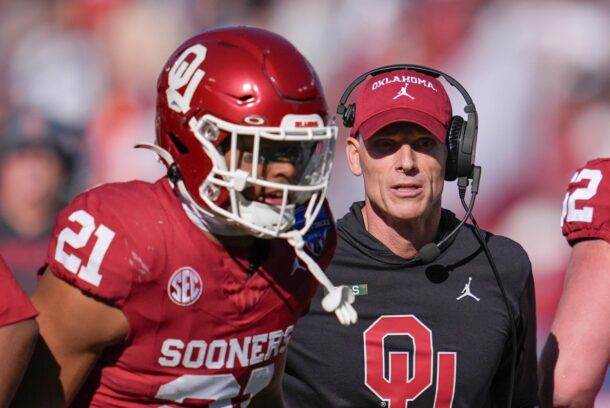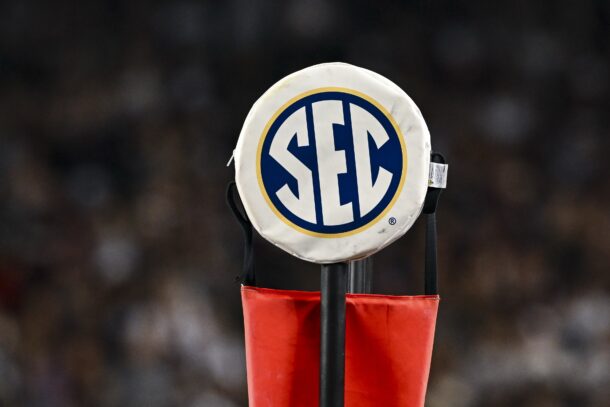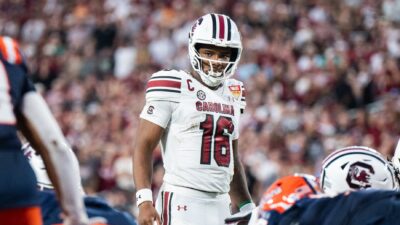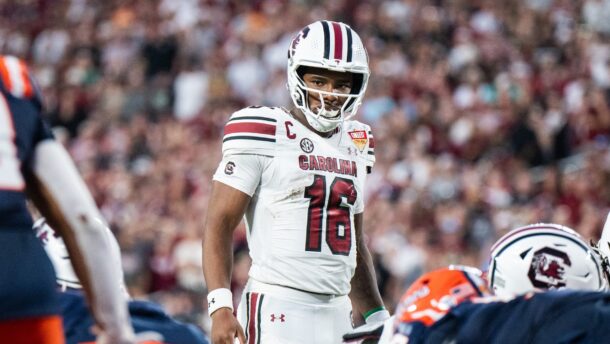
SEC takeaways from ESPN’s percentage of returning production rankings for 2025
There are few things that I click on faster than Bill Connelly’s percentage of returning production rankings. Every year, it’s a fascinating read because it sheds light on something that everyone wants to know.
“Should my team progress or regress?”
That’s what percentage of returning production is designed to project. It’s a better metric than amount of returning starters because as Connelly outlines, the formula is tweaked every year. There’s nuance. Not every returning starter is created equally, and not every position carries the same value. Not every transfer is seen as a net loss because production in the college game is ultimately what matters for these rankings.
As of Feb. 24 — Connelly will update this after the spring transfer portal window — this is where SEC teams rank among the 136 FBS programs:
- 6. Texas A&M
- 8. Vanderbilt
- 10. Oklahoma
- 18. Florida
- 22. Auburn
- 35. Alabama
- 37. Mississippi State
- 38. LSU
- 51. Mizzou
- 52. Kentucky
- 58. Tennessee
- 64. Arkansas
- 71. South Carolina
- 103. Texas
- 105. Georgia
- 113. Ole Miss
There’s a ton to dissect there, plenty of which we won’t have time to get to today.
For now, here are my biggest SEC takeaways from Connelly’s initial percentage of returning production rankings:
Your 2024 SEC Championship participants are both outside the top 100
Texas (No. 103) and Georgia (No. 105) won’t have the benefit that other College Football Playoff teams like Clemson (No. 1) and Arizona State (No. 2) have. Make of that what you will. Last year, Georgia was No. 28 in percentage of returning production and it entered the year as the preseason No. 1 team in the AP Poll. That resulted in a 2-win regression for what turned out to be arguably Kirby Smart‘s most disappointing team. Texas, on the other hand, is outside the top 100 even though it returns a likely preseason All-American at each level of its elite defense.
Georgia and Texas are in the camp that can often debunk the percentage of returning production rankings because of how well they recruit and develop talent. Stacking top-5 classes and top-10 finishes with at least a half dozen NFL Draft picks is a good way to get the benefit of the doubt. We’re talking about 2 programs that’ll still start in the top 5 as one of the 3 favorites to win a national title.
But it’s interesting that both programs will be in this spot with new starting quarterbacks. If you’re not on board the Arch Manning hype train but perhaps lacking data points to make that case, point to Texas returning just 29% of its offensive production (No. 126 out of 136 FBS teams). That’s because he’ll have 4 new starters on the offensive line with Texas’s top-3 pass catchers off to the NFL. Gunner Stockton will also be working with the majority of UGA’s top-pass catchers gone, though replacing a good chunk of the group that led FBS in drops might be a net positive.
Don’t let Texas A&M’s defensive line turnover fool you
Nic Scourton, Shemar Stewart and Shemar Turner could all hear their names called in the first 2 rounds of the NFL Draft, and some will assume that means Mike Elko’s squad is destined for a Year 2 regression. Nope. Look beyond that position group and you’ll quickly see that A&M returns plenty of key pieces from its 2024 squad, which is why it sits at No. 1 in the SEC and No. 6 nationally in percentage of returning production.
Sure, it helps that A&M’s portal haul included productive players like NC State receiver KC Concepcion and Georgia corner Julian Humphrey, but that No. 6 ranking is heavily weighted on A&M’s returning starters. Marcel Reed will enter his first full season as A&M’s QB1 with the benefit of all 5 returning starters on the offensive line, which bodes extremely well for All-SEC running back Le’Veon Moss. That’s monumental.
Also significant is the fact that linebacker Taurean York and Scooby Williams return for an A&M defense that’s loaded with experience in the middle. While I definitely wouldn’t point to A&M’s experienced secondary being a strength — go back to Mike Elko’s post-bowl game rant about how it still hadn’t figured out how to play zone coverage yet — the portal additions of Humphrey and Jordan Shaw at least helped address that.
The SEC’s last remaining unbeaten from conference play in 2024 might have a better shot of finishing in SEC contention in 2025.
Surprised by Oklahoma being in the top 10 in percentage of returning production? You shouldn’t be.
I know what you’re thinking. The 3 players who represented Oklahoma at SEC Media Days (Jackson Arnold, Billy Bowman and Danny Stutsman) are all gone, as are pass-catchers like Nic Anderson, Bauer Sharp, Andrel Anthony, Jalil Farooq, JJ Hester and probably 10 other guys that I’m forgetting.
But what’s important to note is that OU was without its top 5 receivers before the calendar turned to October. Those guys weren’t exactly huge losses from a production standpoint (I’ll still argue that Nic Anderson could turn into an All-SEC player at LSU this year). And as brutal as it was to watch 8 different offensive line combinations after it entered the year without any returning starters in that group, OU should now benefit from continuity, as well as the additions of plug-and-play right tackle Derek Simmons (Western Carolina) and 5-star true freshman Michael Fasusi.
OU’s No. 6 ranking in offensive returning production is also boosted significantly by Washington State transfer John Mateer, who led FBS in quarterback rating in November. OU’s 2025 story will largely be based on how well he transitions to the SEC.
Let’s also not dismiss how many proven players Brent Venables has returning on his defense. Kip Lewis, R Mason Thomas and the Bowen brothers (Peyton and Eli) will lead a defense that should again be one of the SEC’s best. That group shouldn’t have a drop-off in talent, and if it can get any help from the OU offense — something it never had in 2024 — it could be a top-10 unit in the sport. OU, even with a daunting schedule, is an intriguing candidate to progress in 2025.
Ole Miss’s SEC-worst ranking confirms exactly why 2024 was such a lost opportunity
I’m of the belief that 2024 Ole Miss will go down as one of the most painful seasons to look back on of any team in the Playoff era. Why? Well, you know. The team had its highest preseason AP Poll ranking since the Richard Nixon administration, it had the prolific 3rd-year starter at quarterback who earned first-team All-SEC honors at season’s end, it had 1 of the 5-6 best defenses in the sport and it finally got over the hump against elite competition by taking down Georgia … and yet it missed out on the 12-team Playoff.
This isn’t the place where we revisit Lane Kiffin‘s complaints about Ole Miss’s résumé and how if his team had simply beaten 4-win Kentucky at home, it wouldn’t have been a debate. This is, however, the place where we revisit exactly why 2024 will haunt Ole Miss fans in 2025.
The SEC’s last-ranked team in percentage of returning production doesn’t necessarily have a poor preseason outlook — quarterback Austin Simmons living up to the hype is essential to avoid a major regression — but it has far more questions than answers. We’ve seen how low Ole Miss’s defensive floor is during the Kiffin era. Will it be a floor-type season with perhaps 5-6 Ole Miss defensive players getting selected in the NFL Draft? Much of that is an unknown.
What we do know is that last year, Tennessee was the only team that made the Playoff after starting outside of the top 100 in percentage of returning production. Kiffin following in the footsteps of his former school would be the best way to wash away last year’s disappointment.
And the 1 thing I wonder about beyond Vandy’s No. 8 ranking is ____________.
I don’t mean to disrespect the most turnt program in college football, but the 1 thing I wonder about is Vandy won 6 games that were decided by 10 points or less. To be fair, being +2 in games decided by 10 points or less doesn’t guarantee that regression is imminent, but it’s fair to be a touch skeptical of a coach entering Year 5 who hasn’t had consecutive 4-win seasons.
That felt disrespectful. It wasn’t. It was simply an acknowledgment that a program that reached a bowl game in consecutive seasons once isn’t exactly a lock to repeat that level of success, even with that No. 8 percentage of returning production ranking.
What’s perhaps lost in the shuffle of the Diego Pavia-New Mexico State crew that turned Vandy into a respected SEC program was how much better the defense was with Clark Lea calling plays as his own DC. That group ranks No. 10 in returning defensive production after improving by 13 points per game. That could bode well for Vandy avoiding a back-to-earth season.
At the very least, percentage of returning production won’t prevent the fightin’ Pavias from repeating the out-of-body experience that was 2024.
Connor O'Gara is the senior national columnist for Saturday Down South. He's a member of the Football Writers Association of America. After spending his entire life living in B1G country, he moved to the South in 2015.







